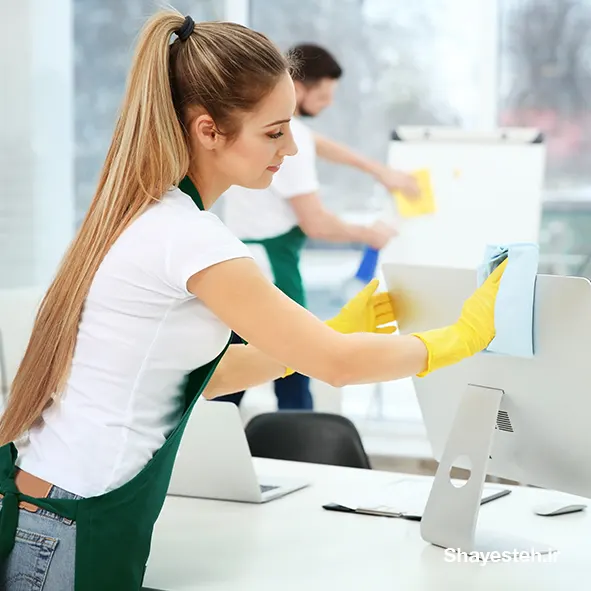در صورتی که اشکالی در ترجمه می بینید می توانید از طریق شماره زیر در واتساپ نظرات خود را برای ما بفرستید
09331464034A case study of a risk assessment for general office cleaning
مطالعه موردی ممیزی ریسک در زمینه نظافت عمومی اداره

<strong> </strong>
A commercial cleaning service took on a new <strong>contract</strong> to clean an office complex.
یک شرکت خدماتی نظافت ادارات، <strong>قرارداد</strong> جدیدی برای تمیز کردن یک مجتمع اداری بسته است.
Before sending cleaning staff to the offices, the manager of the cleaning service carried out a risk <strong>assessment</strong> using guidance provided by the Health and Safety Executive (HSE).
قبل از اعزام نظافتچیان به دفاتر، مدیر موسسه خدمات نظافت با استفاده از راهنمایی های ارائه شده توسط اداره بهداشت و ایمنی (HSE) <strong>ممیزی</strong> ریسک را انجام داد.
To identify the hazards, the cleaning service manager visited the office complex and walked through the areas where cleaning staff would be working, noting things that might pose <strong>potential</strong> risks.
برای شناسایی خطرات، مدیر موسسه خدمات نظافتی از مجتمع اداری بازدید کرد و در مناطقی که نظافتچیان قرار است آنجا مشغول به کار شوند، قدم زد و مواردی را که ممکن است خطرات <strong>بالقوه</strong> ایجاد کند را متذکر شد.
Following this, he <strong>consulted</strong> the health and safety representatives of the cleaning service about these risks, taking into account the needs of any particular staff members, such as whether they were pregnant or aged under 18.
به دنبال آن، وی با در نظر گرفتن نیازهای خاص هریک از کارکنان، مانند باردار بودن یا زیر 18 سال بودن، در مورد این خطرات با نمایندگان بهداشت و ایمنی موسسه خدمات نظافتی <strong>مشورت</strong> کرد.
In order to gather further information, he then had a meeting with the client company during which a number of issues were <strong>discussed</strong>.
به منظور جمع آوری اطلاعات بیشتر، سپس جلسه ای با شرکت مشتری داشت که طی آن برخی از مسائل، مورد <strong>بحث</strong> و بررسی قرار گرفت.
These included the client company’s own standard of housekeeping, such as the immediate clearing up of spills and keeping walkways clear, as well as the <strong>action</strong> to be taken if a fire broke out.
اینها شامل استانداردهای خود شرکت مشتری برای نظافت اداره، مانند پاکسازی فوری مواد ریخته شده و تمیز نگه داشتن مسیرهای تردد، و همچنین <strong>اقداماتی</strong> که در صورت وقوع آتش سوزی باید انجام شود، بود.
He also established what facilities and equipment would be available to the cleaners, including the amount of storage space available, as well as the <strong>availability</strong> of sinks and taps, etc.
وی همچنین مشخص کرد که چه امکانات و تجهیزاتی در اختیار نظافتچی ها قرار می گیرد، از جمله اندازه فضای نگهداری دردسترس، همچنین <strong>در دسترس بودن </strong>سینک و شیرآلات و غیره.
and agreed on a method of reporting near-miss accidents and risks discovered by <strong>cleaners</strong> (e.g. damaged floor tiles).
و توافق در مورد روشی برای گزارش تصادفات و خطرات احتمالی که توسط <strong>نظافتچی</strong> ها (مانند آسیب دیدگی کاشی های کف) مشاهده می شوند.
Following the <strong>meeting</strong>, the manager created a risk assessment document.
پس از <strong>جلسه</strong>، مدیر، صورتجلسه ای برای ممیزی ریسک تهیه کرد.
He wrote down who could be harmed by each risk or hazard identified and in what way, and he then described what controls, if any, were in existence to manage these <strong>hazards</strong>.
او یادداشت کرد که بروز هر خطر یا ریسکی که شناسایی شده ، به چه کسی و چگونه می تواند آسیب برساند، و سپس توضیح داد که در صورت بروز خطر، چه روش های کنترلی برای مدیریت این <strong>خطرات</strong> وجود دارد.
The manager then <strong>compared</strong> these to the good practice guidance set out on the HSE’s website and identified any areas where improvement was needed.
سپس مدیر این موارد را با راهنمای اقدامات مناسبی که در وبسایت HSE ارائه شده بود <strong>مقایسه </strong><strong>کرد</strong> تا هر زمینهای که نیاز به بهبود داشت را شناسایی کند.
The manager discussed the findings with the cleaning staff, making sure they understood the risks of the job and how these risks would be <strong>monitored</strong>.
مدیر، نتایج را با نظافتچیان در میان گذاشت و مطمئن شد که آنها خطرات کار و نحوه <strong>نظارت</strong> بر این خطرات را درک می کنند.
One cleaner, whose first language was not English, had difficulty understanding this, so the manager arranged for translation to be done by a <strong>bilingual</strong> cleaner from another team.
یکی از نظافتچی ها که زبان مادری او انگلیسی نبود، در درک این موضوع مشکل داشت، بنابراین مدیر ترتیبی داد تا متن توسط یک نظافتچی <strong>دو زبانه</strong> از تیم دیگری برای او ترجمه شود.
Finally, to ensure that all the cleaning staff had access to a copy of the risk assessment, the manager pinned a copy in the cupboard where cleaning <strong>equipment</strong> was kept.
در نهایت، برای اطمینان از اینکه همه نظافتچیان به یک نسخه از متن ممیزی خطر دسترسی دارند، مدیر یک نسخه از آن را به در کمد محل نگهداری <strong>تجهیزات</strong> نظافتی سنجاق کرد.
Questions & answers
Questions 15-21
Complete the flow-chart below.
Choose ONE WORD ONLY from the text for each answer.
Write your answers in boxes 15-21 on your answer sheet.
Stages followed by manager in carrying out risk assessment
He visited the offices to be cleaned and noted potential risks.
He talked to health and safety 15 ………………. about the risks.
At a meeting, he talked to the client company about
- the policy of the company regarding 16 ………………. (e.g. clear walkways)
- procedures to be followed in case of a 17………………….
- facilities available to cleaners (e.g. space available for 18 ………............)
- a way of 19 ……………… risks and hazards.
He created a risk assessment document identifying existing controls of risks and hazards.
He compared these to information that the HSE provided on its 20 ………………….. .
He displayed a copy of the risk assessment inside a 21 …………….. available to all cleaning staff.
نظرات کاربران
هنوز نظری درج نشده است!